Magnificent Meteora
Meteora is a stunning group of Greek Orthodox monasteries perched high on monolithic 1,200-foot high rock pillars. Meteora may not immediately spring to mind when planning a trip to the Greek mainland. Certainly not for those in search of famed archaeological wonders, such as an ancient theater, or the perfectly proportioned ancient temples of Athens.
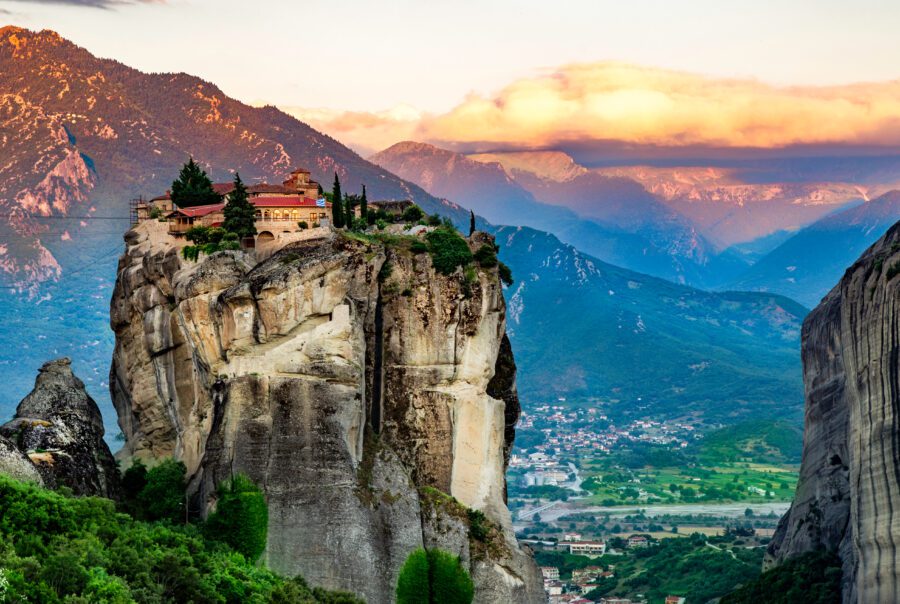
Stunning Views of the Rock Formations of Meteora | Photo credit: Shutterstock
Meteora is one of the best day trips in Northern Greece and possibly all of mainland Greece: well worth the travel time from either Athens (five hours by train) or Thessaloniki (three hours by train). It is also eminently worthy of an overnight stay, to capture this most famous landmark’s magical sunrises and/or sunsets.
This post contains affiliate links, including links from the Amazon Associates programs. These links will direct you to products I recommend for further exploration and enjoyment of the topics I cover on my website and in my lectures. See more in the Privacy Policy below.
Visiting Meteora on a Cruise
Cruise ships stopping at Volos invariably offer a full-day excursion to Meteora: which along with Mount Olympus, is the Volos’s most popular destination. These bus tours are the simplest, easiest way to enjoy a hassle-free guided tour of Meteora. Alternatively, it is possible to book privately guided tours to Meteora from Volos. This is a full length day, so be sure to carefully check the ship’s all aboard times.
Meteora Monasteries Full day Private Tour
Meteora Shows you a Different Greece
Meteora is one of the best places to experience the dominant religion of modern-day Greece: Orthodox Christianity. While the main attraction of this important site is the constellation of monastic complexes built on top of huge monolithic rock pillars, an extended visit to Meteora is also a great way to enjoy some active exploration of this bastion of Greek culture.
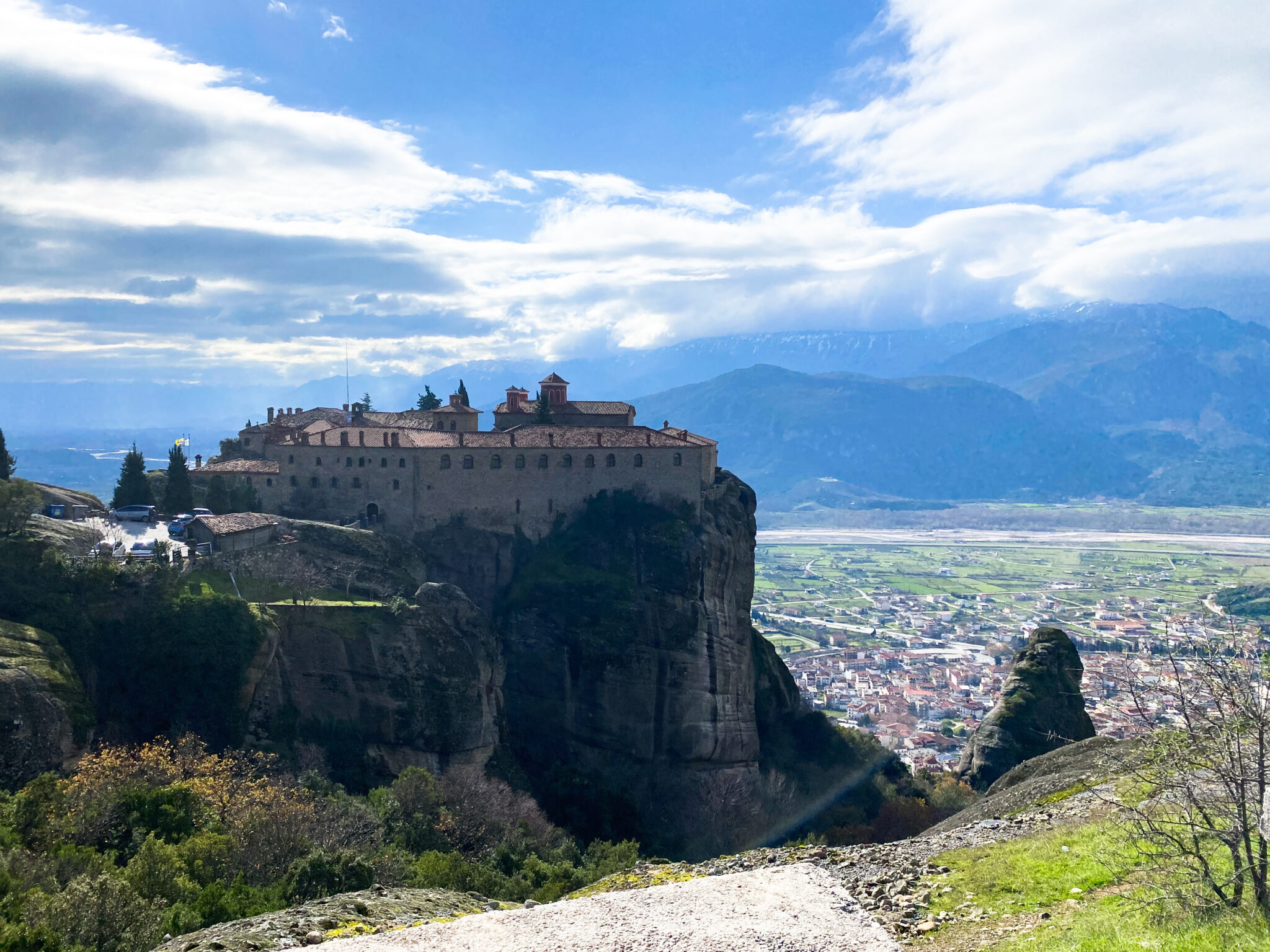
Photo credit: Jennifer Eremeeva
Meteora and Thessaly may prove a different Greece than the one you imagined: Northern Greece, which borders present day Macedonia is not the intense blue and white of of the beautiful beaches of the Greek islands, which dot the Aegean Sea, so rich in the archaeological remains of the glory of Ancient Greece. Meteora introduces visitors to different, often less explored, chapters of Greek, Byzantine, and Ottoman history.
But Meteora is no less appealing with its dramatic rock formations that make one feel, at the highest point, that this is truly the center of the world. I never visit Meteora without feeling an immense sense of awe at what humanity can achieve. Ascending to these ancient centers of faith and fortitude, perched on their prehistoric rocks, is an act of faith and one that is rewarded by an intense sense of calm and tranquility that is hard to find on the ground in today’s world
Join my Newsletter Community
Twice monthly, I’ll send you a digest of my latest articles and posts, travel and food news, and exclusive recommendations you won’t find anywhere else!
Meteora’s Ancient History
Though Meteora, which means, “lofty,” or “suspended in air,” is known primarily for its stunning monastic complexes, its soaring rock pillars are far older than Christianity. These unique formations were created roughly 10 million years ago, when the broad plain of Thessaly was an estuary. Millennia of corrosion of silt and rock formed the pillars, smoothed by the water of this prehistoric water body.
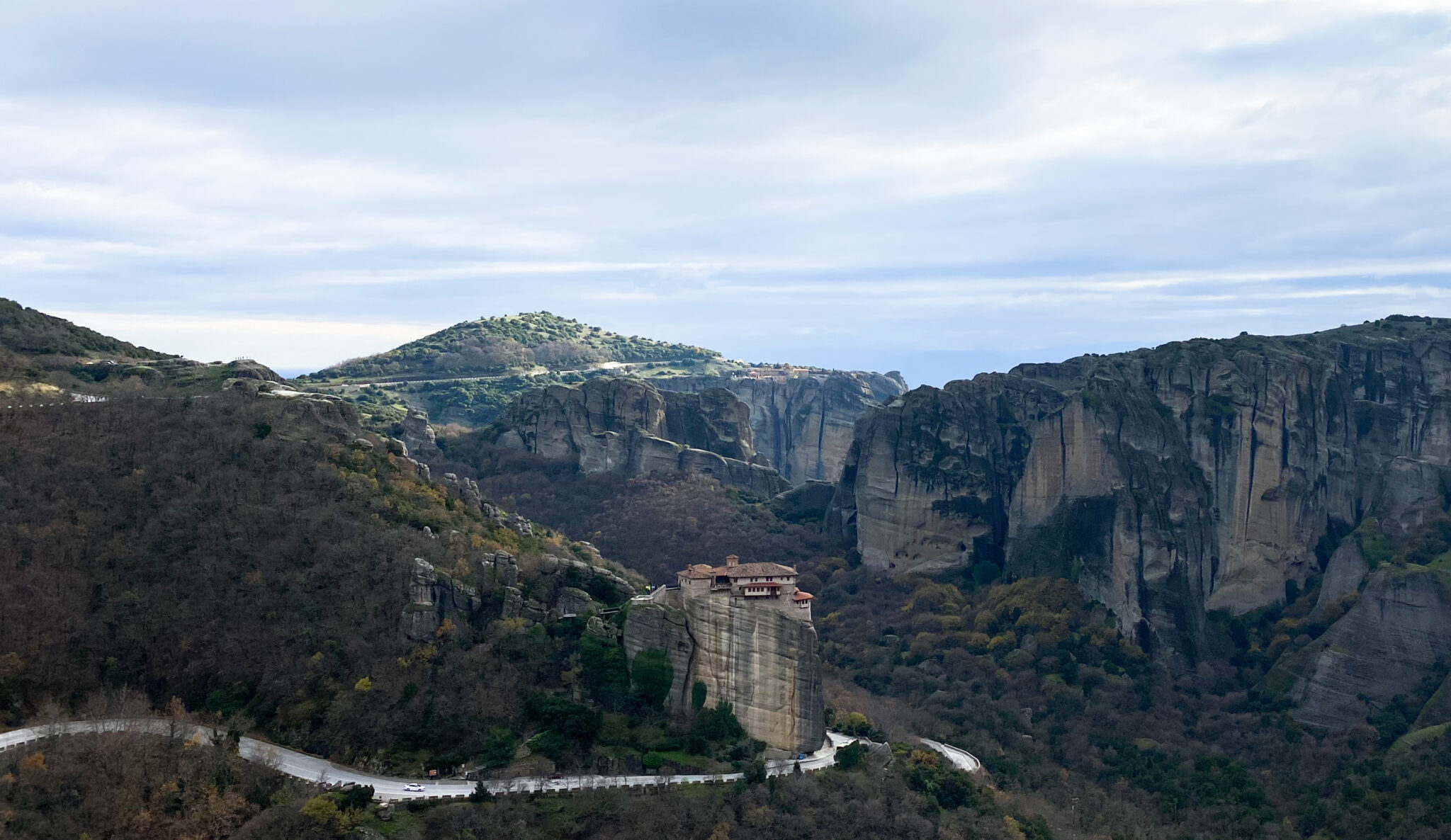
Some 15,000 years ago, a major earthquake rent the valley, and estuary drained, revealing the unique rock formations, which now soared from the earth to seemingly impossible heights. The Ancient Greeks considered the pillars the playthings of the deities of Greek mythology, who dwelt on the summit of nearby Mount Olympus. In ancient Greek history, Meteora was known as Aeolia, a rich agricultural heartland in mainland Greece, famed for its horses, the finest in the ancient world.
Meteora as a Hermitage for Early Christians
For 2nd and 3rd century Christians, the area held a unique appeal. Christians were convinced the pillars fell from heaven by some miracle. And the remoteness of the area and the natural caves in the rock formations were ideal for the growing number of ascetics. These were devout Christians — men and sometimes women, who were weary of the evil of the world and eager to retreat from it, to emulate Christ’s time in the wilderness in prayer and fasting.
Hermits attracted many followers, who were eager to emulate the simplistic life of the hermits, but who lacked the physical discipline to do so. This was the beginning of the monastic movement, which began in Northern Africa and spread throughout the early Christian world.
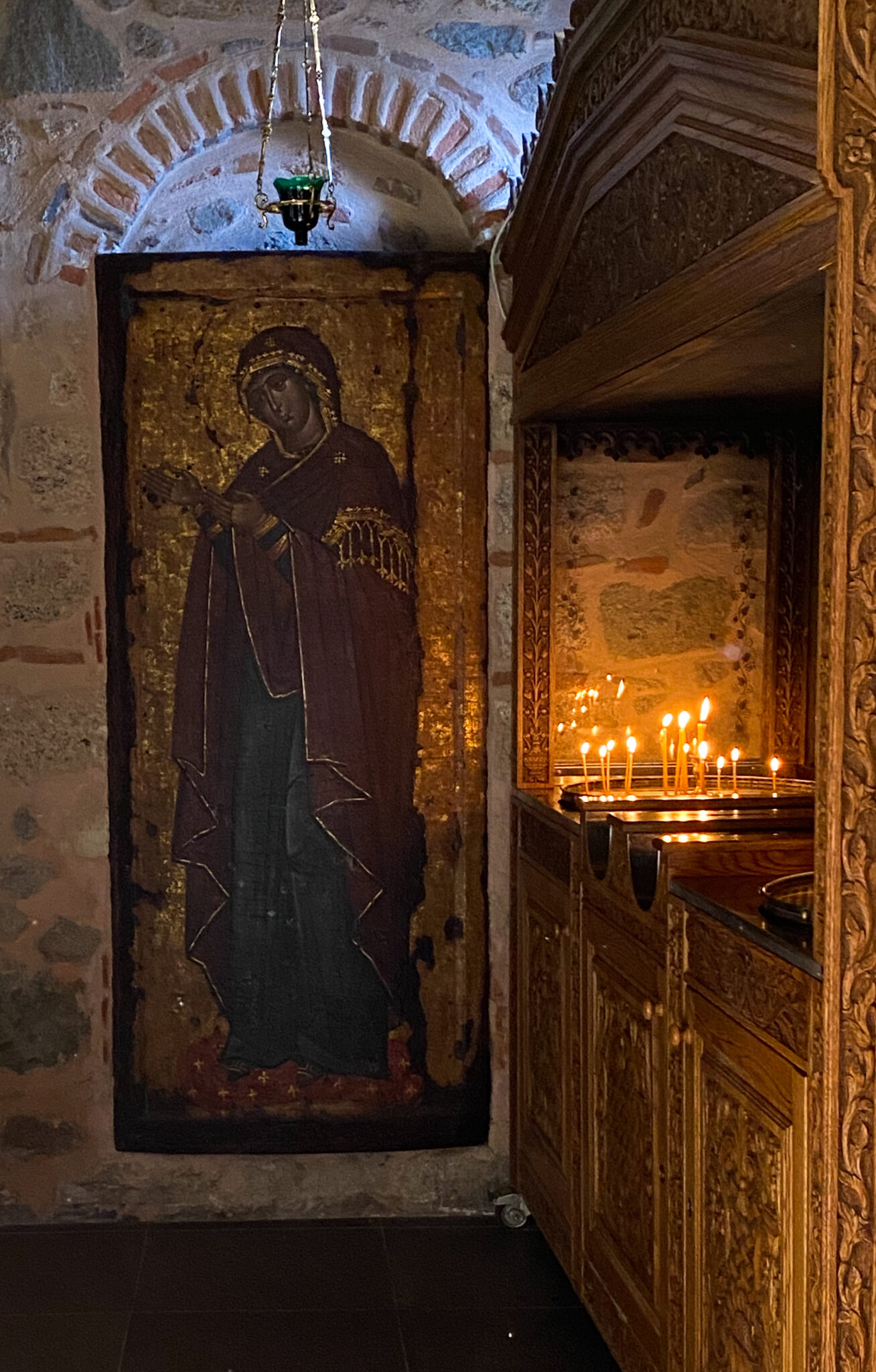
The windswept desolation of Meteora provided the ideal retreat from the messy politics of the Byzantine Empire. As the centuries passed, and the Eastern Roman Empire crumbled, Meteora’s community continued to attract those who sought a simpler life and a closer relationship with God.
The 14th Century Ascent to the Peaks of Meteora
At first the monks lived solitary lives in constant prayer in carved into the face of the rocks by centuries of wind. In the 14th century, as the outposts of the Byzantine Empire came under increasing attacks, the hermits banded together to conceive of a monastic complex built on the pinnacle of the rocks. There, they reasoned, they would find the ultimate retreat, a place to devote their lives to prayer and contemplation as close to Heaven as they imagined possible on earth.
Only sincere and zealous faith could have enabled them to execute the engineering challenge that lay before them. For decades, the monks moved building materials up the steep, wind-battered heights of the rocks, using ropes and pulleys, treacherous rope ladders, donkeys, and the strength of their own backs.
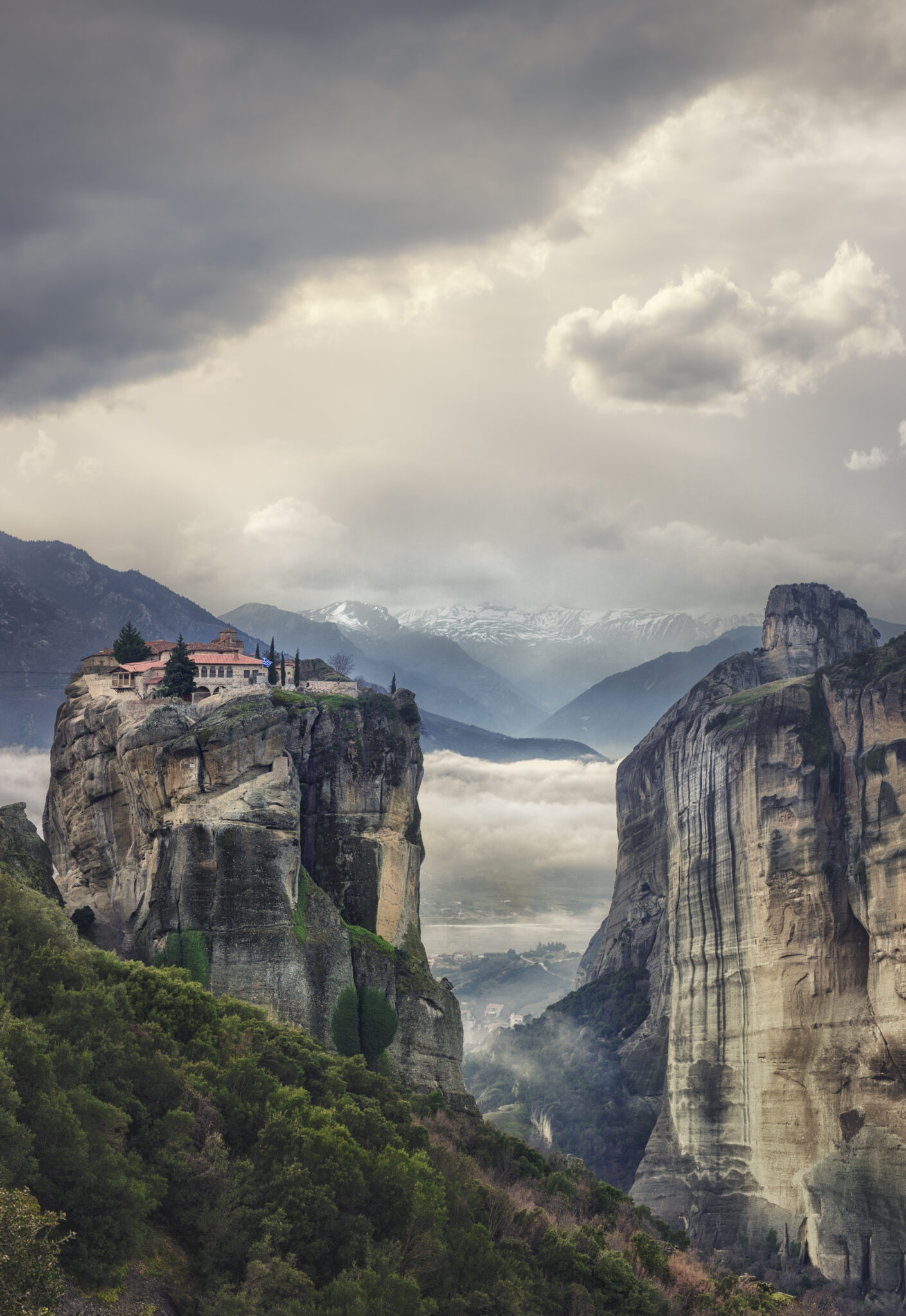
Photocredit: Wikimedia Commons
Legend has it that for the construction of the Monastery of Varlaam, it took twenty-two years to haul the building materials up to the site, while the actual construction of the monastery took a mere twenty days. This may be a slight exaggeration, but the determination of the monks — as well as the climb up — leaves one breathless today.
The unique monastic communities at Meteora continued to attract monks, nuns, and hundreds of pilgrims; achieving popularity in Greece, second only to the holiest island monastery at Mount Athos, which prohibited women from setting foot on its shores. The safety, security, and solitude of Meteora were protected by its inaccessibility: the only way up to the top was by a wicker basket, attached to a windlass, pulled by ropes, which the monks believed they should replace only, “when the Lord allows them to break.”
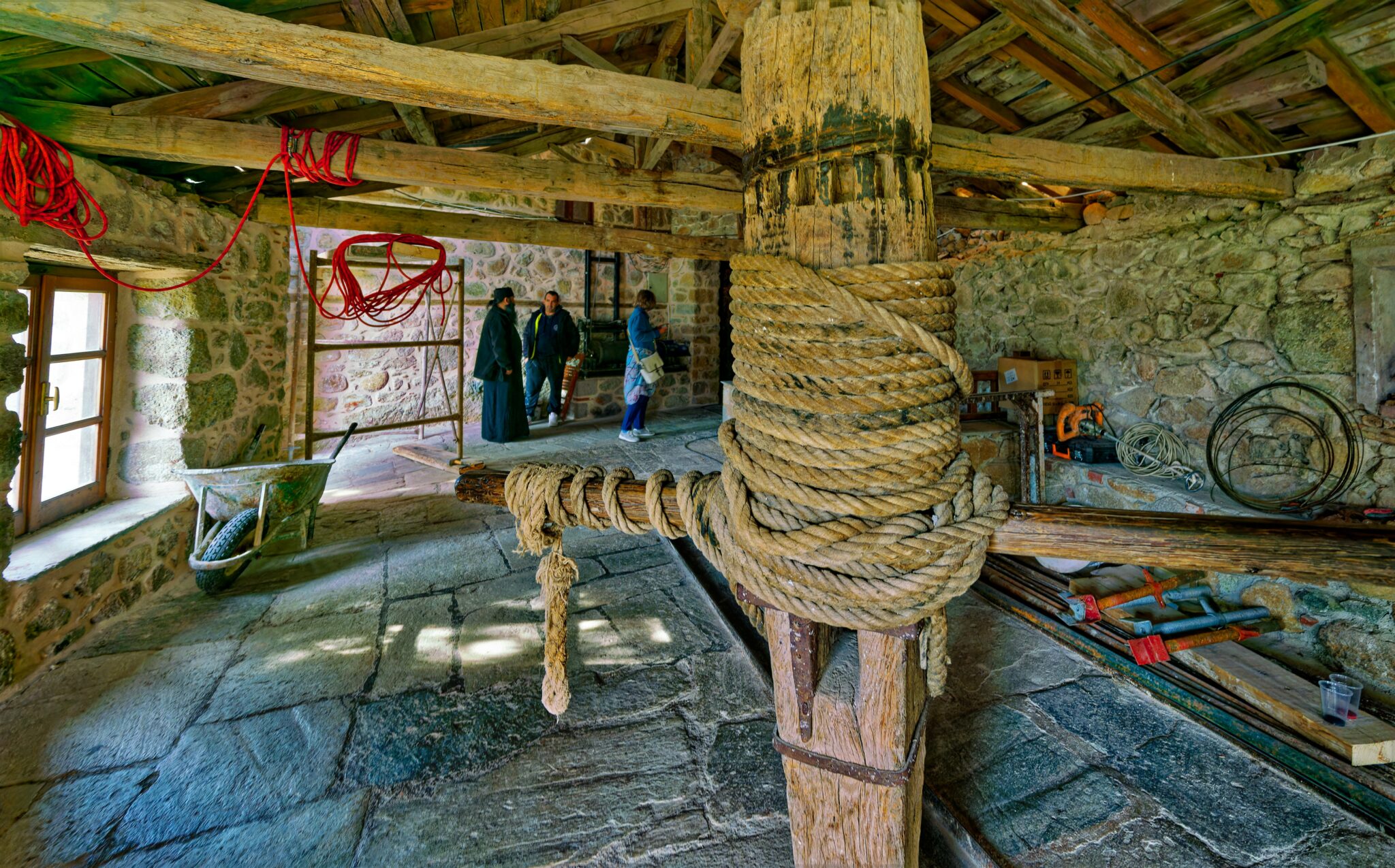
One of the working windlasses, used to hoist people and goods to the monasteries | Photo credit: Wikimedia Commons
The faithful were apparently willing to brave the harrowing ascent to experience the spirituality that many believe is still present today. Sustained by donations of food from the local population on the ground, and the tithes of pilgrim visitors up top, Meteora thrived. Between the 14th and 16th-centuries, the number of monasteries grew to 24, of which six remain active today: Great Meteoron, The Holy Trinity Monastery, Rousanou, Saint Nikolas, Varlaam, and Saint Stephen.
Meteora: A Symbol of Greek Nationality
Though Meteora was conceived and constructed by its builders as a refuge and retreat from the world, as Greece fought for independence against the Ottomans in the 17th – 19th centuries, the monasteries became an essential center of both national and cultural identity and a safe hiding place for the country’s independence fighters.
Modern Meteora
Today, only a handful of monks and nuns remain at the six monasteries, men and women who have dedicated their lives to extreme solitude, prayer, and contemplation, just as their antecedents did. UNESCO recognized Meteora’s unique history in 1998, when the monastic complex garnered the status of a UNESCO World Heritage Site.
Modern-day pilgrims avail themselves of the far-less frightening stairs that have taken the place of the more precarious medieval windlasses and ladders to climb up and experience the enduring magnificence and mystery that is Meteora.
The Working Monasteries and Convents of Meteora
The Great Meteoron
The founder of this oldest and most venerable of the monasteries was St. Athanasios of Mount Athos. It reached its apogee during the 16th century thanks to imperial patronage. It has several chapels dedicated to St. John the Baptist, and Saints Constantine and Helena.
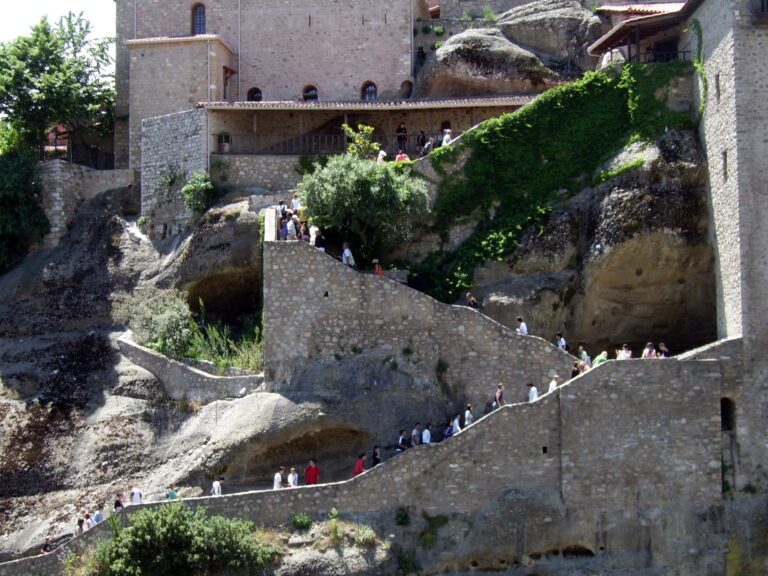
The Monastery of Varlaam
The Monastery of Varlaam takes its name from the monk, Varlaam, said to be the first to conceive of the idea to climb the rocks in the 14th century and build the monastic complexes on their peaks. Sadly, he had no followers and died alone, and the monastery was empty for two centuries after his death. Varlaam’s excellent museum is open to visitors and contains outstanding applied art, relics, manuscripts, and ecclesiastical vestments.
The Monastery of Rousanou
The Rousanou Monastery was founded in the 14th century but underwent extensive renovations in the 16th century. In the 19th century, the monastery declined and was turned into a nunnery after restoration in the 1980s.
The Holy Monastery of St. Nicholas Anapafsas
Dating back to the 14th century, the Holy Monastery of St. Nicholas Anaphases is famous for its outstanding painting by the 16th century Cretan painter Theophanes Strelitzes, better known as Theophanes the Cretan.
The Monastery of St. Stephen
The Monastery of St. Stephen was begun in the 14th century, but extensive renovations in the 18th century give it a more modern feel. Today, St. Stephen’s is home to nuns, following the designation of the complex as a nunnery in the 1960s
The Monastery of the Holy Trinity
The Monastery of the Holy Trinity is perhaps the most famous of the Meteora complex, thanks to James Bond! But it has had an active existence for over seven centuries. From here, there are excellent views of the other monasteries and the rock formations.

Stunning sunsets at the Monastery of the Holy Trinity | Photo Credit: Shutterstock
Visiting Meteora: Practical Information
Shopping in Meteora
The monasteries keep up the excellent tradition of icon painting, and sell them in small shops, but be mindful that they don’t all take credit cards.
In Kalabaka, you will find the usual souvenir shops selling ceramics, leather items, and other souvenirs, but if you are on a day trip from Athens, or a guided bus tour, time may not permit stopping.
Why You Should Extend Your Stay in Meteora Overnight
While the monasteries are the key attraction of Meteora, there is so much more to see and do in the area. If time permits, consider extending your stay to include at least one overnight, and explore deeper and further.
Hotels in Kalambaka & Kastraki
Search for more hotels in Kalambaka (sometimes written “Kalampaka”) and Kastraki.
Other Reasons to Visit Meteora
Fans of James Bond will immediately recognize the rock formations from the For Your Eyes Only (1981), which was filmed at the Monastery of the Holy Trinity.
Meteora also provided the inspiration for one of the more dramatic settings in HBO’s Game of Thrones. The high rock pillars were imagined as the setting of the Eyrie, the stronghold of the Arran Family, where Tyrion Lannister is imprisoned in a sky cell with a dangerous tilt to it. They did not actually film the scenes at Meteora, but from George R. R. Martin’s descriptions of the Eyrie in Game of Thrones, it is clear that Martin has visited Meteora!
Meteora is a Must for Hikers, Climbers, and Scramblers
Meteora’s unique topography draws thousands of hikers, climbers, and scramblers each year. Exploring the region on foot is a fantastic way to enjoy the breathtaking views of the valley and the rock formations. From a full day walk around Meteora, to a full-on rock climbing adventure, and caving adventures, there are many options for an active experience one of Greece’s unique and important sites.
Food-Focused Exploration of Meteora
In stark contrast to the quiet, contemplative, and ascetic life of the inhabitants of the monasteries of Meteora, the region is also a must for those interested in learning about Greece’s traditional foods and wines.
Wine and wine products are popular here, including a sweet jelly called soutzouki, which is made from fermented grape juice and nuts.
Meteora is home to the popular Meteora Natural History and Mushroom Museum, dedicated to one of the region’s most important natural products: mushrooms and truffles. The Museum’s galleries outline the therapeutic and nutritional value of mushrooms, as well as cooking demonstrations and tastings of the many mushroom-based products.

Truffle hunting is a popular pastime from mid-March to the end of October. The Museum also offers food-themed tours: Private Meteora Truffle Hunting and Lunch, and Meteora Food and Wine Private Tour.
What to Pack for Meteora?
In all seasons, the most important consideration on a visit to Meteora of any length is dressing for the weather, as you will be outside in the wind and sun for much of your visit to Meteora. If you plan to visit the interior of the monasteries, be aware that there is a strict dress code:
-
Men must wear long pants and sleeves.
-
Women must wear long skirts and sleeves.
Skirts are available at the entrances of the monasteries, so women should dress in clothes that are suitable for extensive walking and navigating the many stairs and terrain around the rock formations. Avoid shorts, which can get you barred from entrance even with the rental skirt. Err on the side of caution and wear trousers or cropped pants that come down the shin. Avoid tank tops, halter tops, and sleeveless or off-the shoulder blouses.

- Bring a sunhat that will stay on in very windy conditions. I’m a big fan of almost any hat from Tilley Endurables, and the wide-brimmed All Weather Hat or the chic Airflo Hat will keep the hat on and the sun off!
- Sturdy, non-slip footwear like Merrell’s Women Moab 2 Mid Waterproof Hiking Boot, or the Men’s Oboz Sawtooth II Mid B-Dry Hiking Boot.
- A windproof shell such as the Lands End Squall Raincoat or the Marmot Men’s Minimalist Jacket.
- Sunblock like the Cera Ve 50 SPF Sunscreen: bring some with you for frequent reapplications.
- A refillable water bottle: I love my YETI 26-oz Rambler, which keeps water cool for up to 12 hours. I refill it whenever possible to stay hydrated!
- Several extra memory cards for your camera.
- A phone charger, or maybe two, if your phone doubles as your camera. I bring 2 Anker Power Banks with me in my day pack on long full-day excursions like this one. Having my phone completely charged also means I can enjoy audio entertainment on long bus rides.
- If balance and mobility are concerns, or if you plan to make active exploration part of your visit to Meteora, consider a pair of retractable trekking poles such as LEKI’s excellent carbon trekking poles.
- If you are a keen photographer and want to get the best shots, a traveling tripod is a key piece of kit for this visit: the wind at the summits of the monasteries can make it challenging to hold the camera steady.
- This is a day to keep your hands free for photography and holding on to the handrails of the stairs. This is where a great backpack really comes into its own. Three I recommend are:
- Tenba’s Fulton V2 10L All Weather Backback – Great for photographers with gear.
- TUMI’s Celina Backpack effortlessly transitions from hand luggage to day pack, and it comes in a range of very cool colors!
- WANDRD’s All-New Prvke is everything a backpack should be!
Want this as a printable check list?
Enter your email in the box below for instant access to this list and a doawnloadable, printable PDF.
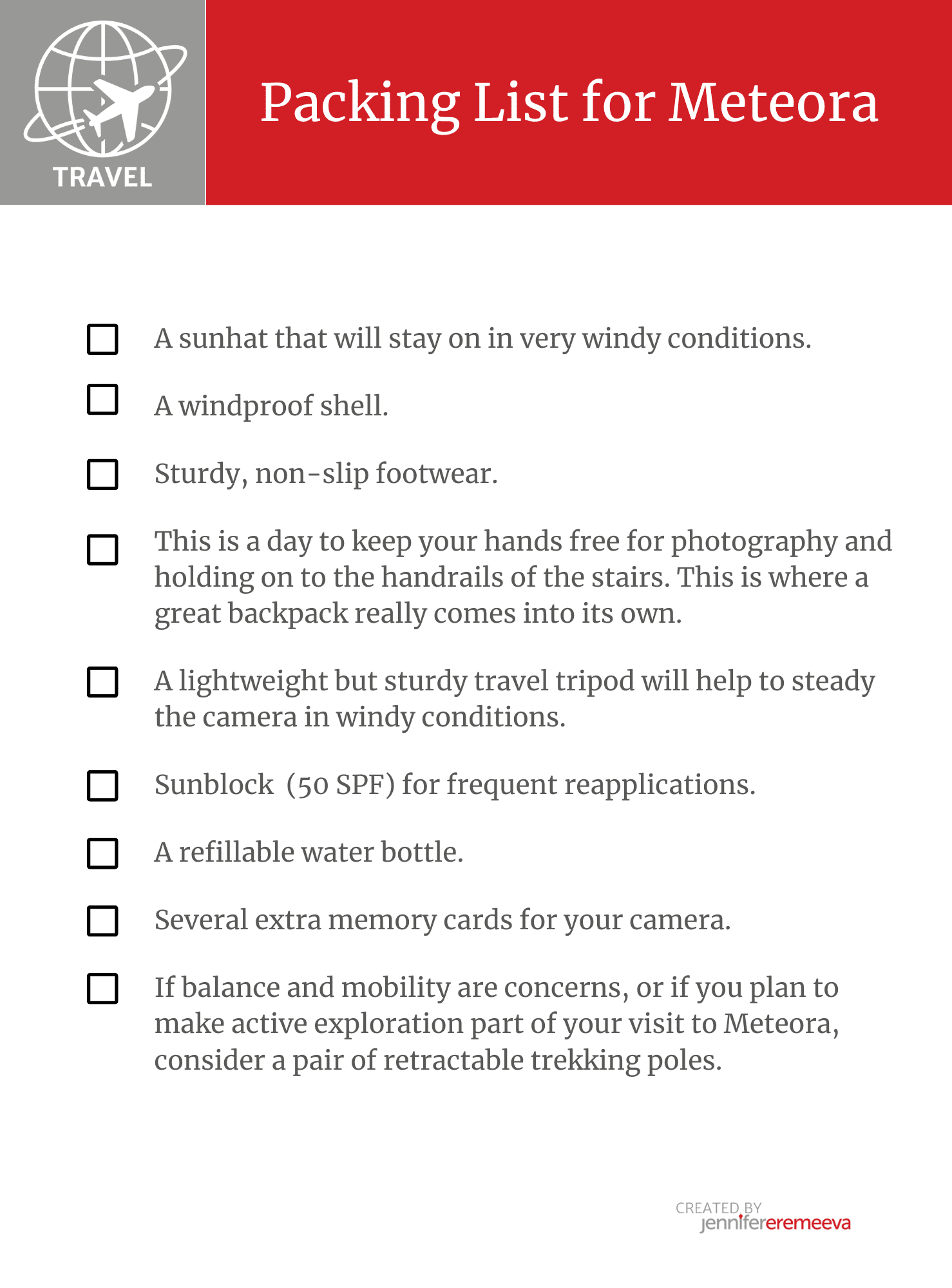
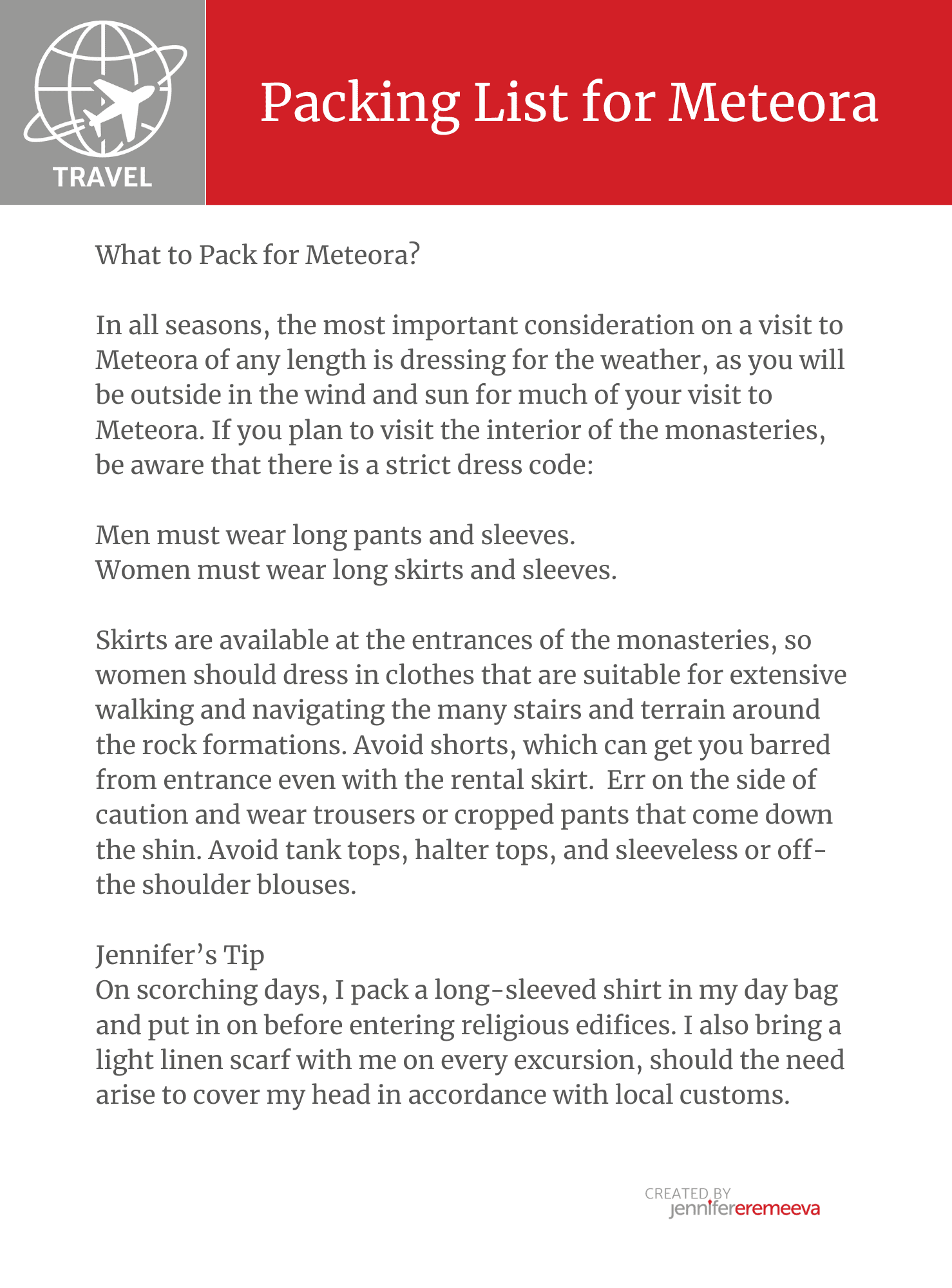
Frequently Asked Questions about Meteora
Do I need to book ahead of time to visit Meteora?
Greece is always popular and becoming more so, thanks to its concerted effort to attract off season tourists. It’s a good idea to plan your trip well in advance and book tours, transfers, and train tickets so you won’t miss out on the opportunity to see Meteora. Hotel space will also fill up quickly during the high season. See my recommendations above.
How do I get to Meteora from Athens?
The best way to get to Meteora from Athens or Thessaloniki is by train to Kalambaka. There are daily bus connections from the Greek Capital, Thessaloniki, and Volos. There are also guided tours by both train and bus with hotel pick ups and drop offs.
Can I get a rental car and drive to Meteora?
Of course! And you will enjoy the scenic drive across the plain of Thessaly. If time permits, consider a 2 Day tour from the Greek Capital, which includes a visit to Delphi’s ancient ruins and the Delphi Archaeological Museum.
Can I wear shorts to Meteora?
There is a strict dress code in place for visiting the monasteries of Meteora, and all visitors must adhere to it. Men are required to wear long pants, and women must wear long skirts. The monasteries provide skirts at the entry. Both men and women should wear long sleeves.
How do you get to the top of Meteora?
By foot! Some Monasteries have car parks near(er) to their entrances, but the Monastery of the Holy Trinity and Great Meteora both have over 300 steps. The steps have handrails and the footing is even, but sturdy foot gear is advisable.
I have mobility challenges. Should I attempt a visit to Meteora?
There are no elevators or handicapped access to the monasteries at Meteora, so if mobility challenges are a concern, you may wish to consider the visit carefully. Of course, you can enjoy the magnificent views of the monastic complexes from the many photo stops, but ascending the 140 – 400 steps and visiting inside may not be possible.
What is the nearest town to Meteora?
The closest town to the monasteries is Kalambaka. The nearby traditional village of Kastraki is also handy for visiting the area.
Is one day enough to see Meteora?
A Meteora day trip from Athens or Thessaloniki suffices to visit 2-3 of the monasteries. But to truly enjoy everything about the region, including a walking tour around the rock formations, visits to the local museums, visits to all the monasteries, and free time to relax and enjoy the marvelous food and drink of the region, the best option is to give yourself least one overnight, near the monasteries. This way, you can be ideally located to witness the famous sunrise and sunset of Meteora.
What is the weather like in Meteora?
The summer months can be very hot — with temperatures above 90ºF normal. The crowds are also at their height. My last visit to Meteora was in December, and it was delightfully cool and relatively free of sizeable crowds. This afforded us enough time to explore the monasteries with our tour guide without having to wait in long lines.
Join my Newsletter Community
Twice monthly, I’ll send you a digest of my latest articles and posts, travel and food news, and exclusive recommendations you won’t find anywhere else!
Enjoy More Articles Like This One

Day Trips from Athens: Meteora, Greece’s Hidden Gem
















